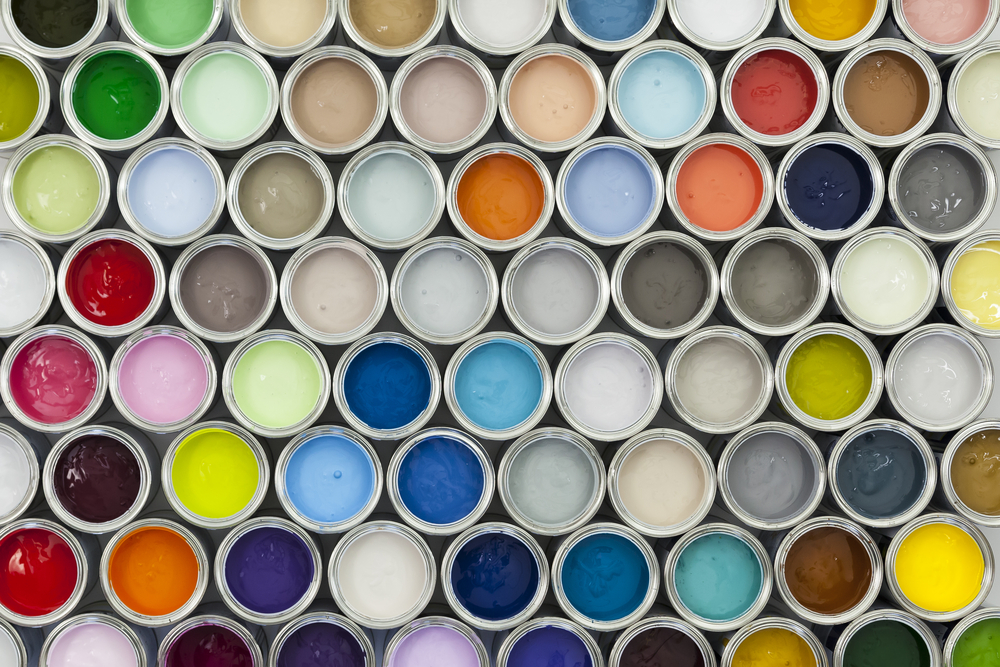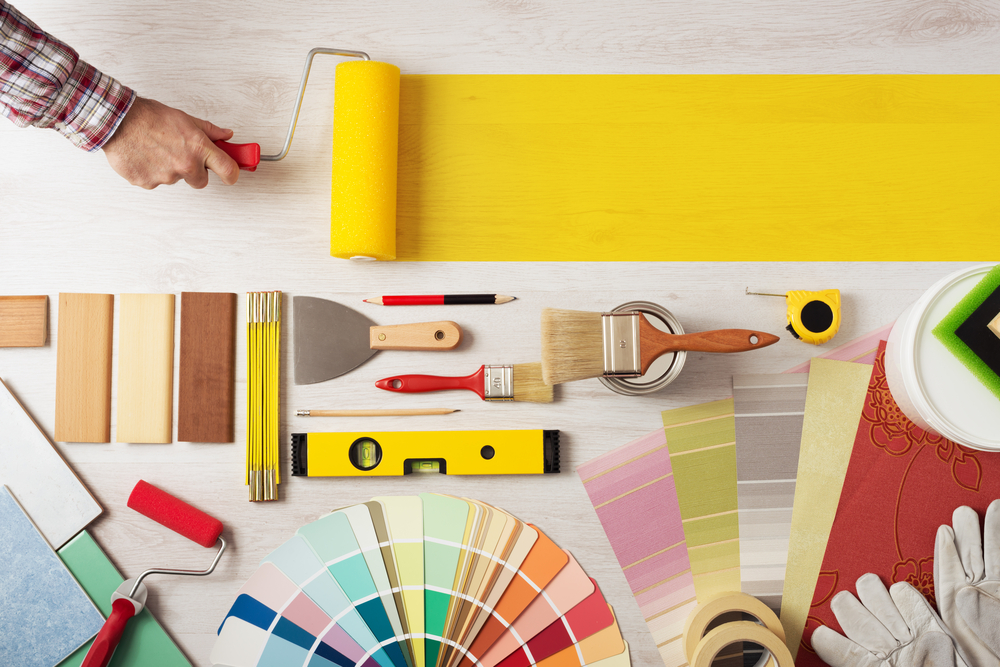Selecting a wall paint may seem like a straight-forward activity, but there are many factors to consider when looking at paint types. There are a multitude of finishes and paint bases available, all suited to different materials or areas of your home.
If you’re feeling a little overwhelmed at the thought of picking out a paint, don’t worry – we’re here to help you out! In this article, we will discuss the different types of paint available, what finishes you should be looking for in your paint, and give you some pro painting tips so you’re ready to get your next DIY paint project started as soon as possible.
Understanding Paint Types
When looking at paints in a hardware store or online, you may be confused by the many different labels that you see on the paints. It is important to understand that paints come with different bases and finishes, and that some should be used with a primer. These are the three main factors you need to consider in your paint and the subcategories of these factors can often be mixed and matched with each other, allowing you to pick the perfect paint combination for your unique situation.
The paint types we discuss in this article are mainly ones for interior use, but some of the bases and general finishes will be the same in many exterior paints.
Paint Bases
There are two main types of bases that your paint can be made out of. These bases are typically formatted for use on different types of materials and can have any of the finishes we discuss below.
Oil-Based Paints
Oil-based paints are the more durable of paint bases. Sometimes called solvent-based paints, the composition of these paints makes them extra affordable and perfect for using on areas like baseboards and doorways, as the paint can stand up to a substantial amount of abuse without damaging or fading.
The one downside of oil-based paints is that they take a long time to dry, much longer than their water-based counterparts, at up to 16 hours of drying time per coat of paint. This will probably add an extra day or two to your painting project time as each coat will need to fully dry before you can add another one.
Oil-based paints also have more fumes than water-based paints and you will probably need to wear a respirator when using them, in addition to having turpentine or paint thinner available to clean off your paint brushes and any painting mistakes.
Water-Based Paints
Often more expensive than oil-based paints, water-based paints are known for their ability to dry much faster and give off less fumes. Sometimes called latex-paints, water-based paints are the best choice for interior walls, because while they are slightly less durable than oil-based paints, they dry faster in between coats.
This means that you can complete your painting project in one to two days, instead of waiting a long time to finish painting. Water-based paints also clean up easier with no turpentine or paint thinner needed, which is a definite plus.
Paint Finishes

A paint’s finish refers to how that paint will look when it is completely dry. This is the aspect of paint that people are generally most familiar with and the part that has the most variety to offer. Finishes range in appearance from non-reflective and almost paper like, to very glossy; the glossier your paint’s finish is, the more expensive the paint is likely to be. These finishes are also all available in either oil-based or water-based paint.
Flat
A paint with a flat finish is the least reflective. It is almost completely matte and paper like in appearance. Flat finishes work to give a cozy, laid-back atmosphere and work well in places like living rooms and formal dining rooms.
Satin
One of the most popular finish choices, satin is similar to flat, but it has a small amount of sheen to it. It works well in bedrooms or dining rooms, or other semi-low traffic areas where a there isn’t too much potential for the paint to become stained or damaged.
Eggshell
Paints with eggshell finishes are balanced in the amount of matte and glossiness they offer. This finish is a perfect compromise if you can’t decide between flat and high gloss, and is suited for using in areas that have higher traffic, such as kitchens, as the gloss makes it easy to wipe off stains and damage with a damp cloth.
Semi-Gloss
Semi-gloss finishes are fairly reflective and tend to bounce light pretty effectively. They are suited to places like bathrooms or kitchens as they are more durable when it comes to staining or damage, and some semi-gloss finished paints are even designed to be moisture resistant for use in these areas.
High-Gloss
Also sometimes called gloss paints, the high-gloss finish is extremely reflective and more decorative. It is easy to clean and best suited for use in areas such as wood trims, baseboards, and doorways, as it is very durable to staining and other damage.
Primer
Before you start painting, you may want to consider using a paint primer. Like paint bases, these come in oil-based or water-based varieties. You should be using an oil-based primer underneath and oil-based paint, and a water/latex-based primer under water/latex-based paints.
Primer is typically available in white, off-white, or grey colors and will help you to even out the surfaces and colorings of your walls; it filles in any holes or empty spaces, providing you with a completely flat, evenly colored surface on which to paint. Primer will help your paint stick to the wall and ensure the color of the paint is equally vibrant across the entire painting surface.
Of course, you don’t always have to start your DIY paint job with a primer, but it does help, especially if your walls have been painted many times before. Keep in mind that if you are changing your wall color to much lighter or much darker than the starting color, a primer (in particular, a high-hide primer) will be essential in helping your new paint color look its best.
Painting Pro Tips

These painting pro tips will help you with everything from selecting the right color for your interior space to giving you the best suggestions on how to protect your paint job and make it last.
Choosing a Color
The most difficult part in selecting a type of paint is choosing the color. After all, this paint color needs to be something that you can live with and appreciate for a long time. When choosing your paint colors, don’t be afraid to request a lot of samples.
Use either paper color samples or find small pots of paint samples and paint or attach them to a piece of wood or other board. You can then move these samples around your home and look at them in all types of lighting and rooms in order to find your favorite one.
Once you have a color selected, you should also look at samples in that color with different finishes. This will help you select the paint color and finish most suited to your painting project.
Combining Paint Types in Your Home
When selecting a paint to use in your home, you should know that you don’t have to select one finish and use it for all of your projects. Many interior painting jobs will combine paint finishes to achieve the most decorative and practical design possible.
For instance, you can use a satin or eggshell color on your walls in the living room, and then finish up the baseboards, doorways, and wood trims with a paint in a semi-gloss or high-gloss. This gives you the most practical design and gives your home a well-decorated feel.
When looking at samples of paint, be sure to request multiple finishes in the same or different colors so you can see which combination of paint finishes suits your home the best.
Protecting Your Paint
If you’re worried about your brand-new paint job getting damaged over the course of its life, you can invest in a paint top coat to efficiently protect your paint. Top coats are generally clear and will give you an extra layer of protection while adding some gloss to your paint job that makes the paint easier to clean and more resistant to stains and damage.
Personalize Your Space With Paint
Selecting a wall paint can be a confusing task, especially with the many types of paint and available finish combinations available out there. The best way to select a type of paint is to understand these paint bases, their finishes, and the rooms they are best suited to; once you are comfortable with this knowledge, you can request the appropriate paint samples and begin your DIY paint journey to personalize your home.
